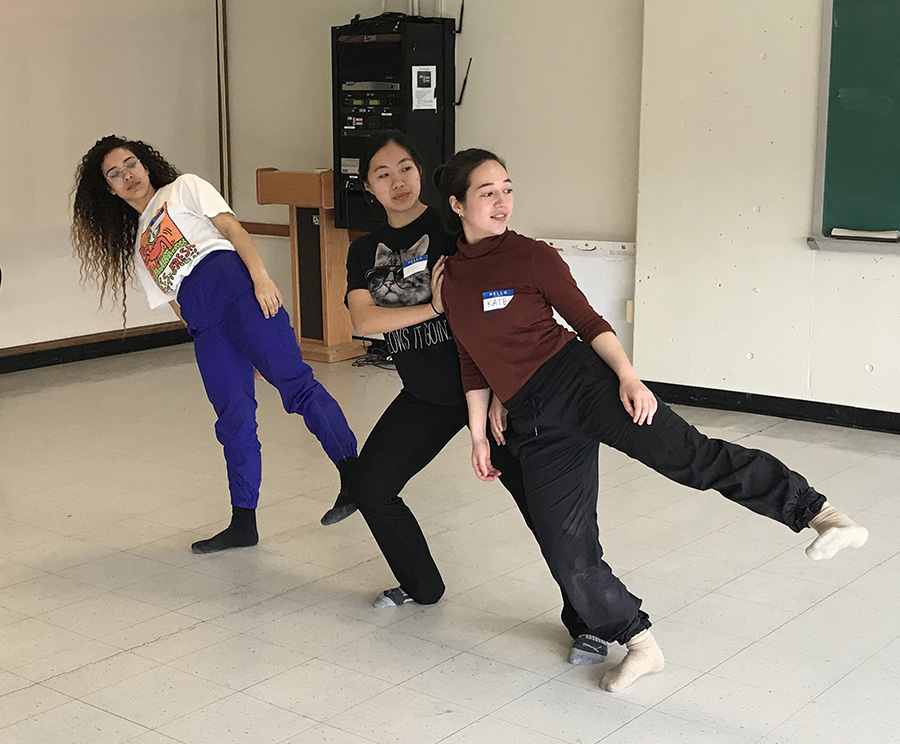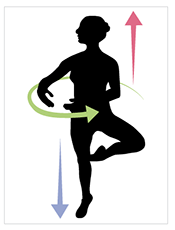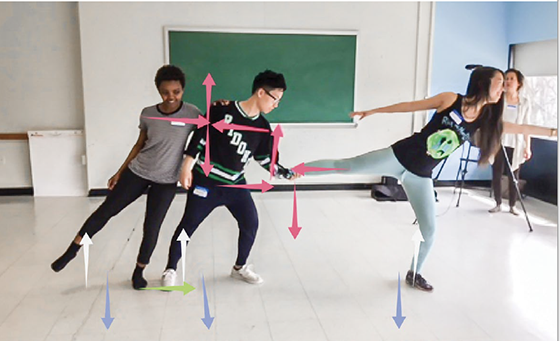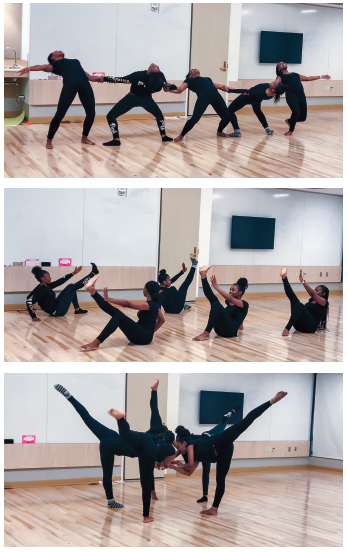Embodied Learning through Dance and Physics
BY FOLASHADE CROMWELL SOLOMON, TRACEY WRIGHT, MARIAH STEELE, AND DIONNE CHAMPION
Scholars across disciplines recognize the power of bodily experiences in shaping cognition. While a number of scholars suggest that dance represents an important type of embodied cognition, the notion of dance as a site for learning is underexplored (Sucato, 2009). Our team received a two-year Exploratory Pathways Project grant from the National Science Foundation’s Advancing Informal STEM Learning program for a project entitled Embodied Physics: STEM Learning for Under-Represented Youth. Embodied Physics constructed a physics course for high school students from two Boston-based dance schools. These young dancers were able to engage in ways of learning that recognized their embodied knowledge of physics, rooted in their experiences as dancers, and that celebrated the cultural knowledge they had developed in their community-based dance schools (see “Building Science Identities,” below).

The Embodied Physics project was comprised of three phases. In Phase 1, we partnered with OrigiNation in Jamaica Plain, MA and Roxbury Center for the Performing Arts in Dorchester, MA. These urban community-based dance studios primarily serve African American dancers and have a history of excellence in dance education and of significant contributions to their wider communities. Next, during Phase 2, we worked with dance students from Boston Conservatory (BOCO) and STEM students from MIT to connect dance experiences to specific physics “tasks,” to help us develop course material. During Phase 3, we drew on what we learned from Phases 1 and 2 to create the Embodied Physics Learning Lab, which allowed 15 high school girls from the two community-based dance studios to come together to explore physics concepts by using their bodies as resources.
Building Science IdentitiesInformal learning contexts provide one avenue for broadening participation in science for underrepresented students. We developed the Learning Lab as part of an effort to explore how such youth can develop not just science knowledge but scientific identities. We hypothesized that embodied learning would provide rich opportunities to learn key ideas in physics and to strengthen their confidence in their ability to become scientists.
Our process began with observing high school dancers learning in environments—their dance studios—where they were already embedded in and engaged with their home communities. The Lab itself was situated in a central location in the students’ neighborhood, and the course supported discussion of physics concepts drawn from their lived and embodied experiences, to help them identify themselves as people who practice and are engaged in scientific inquiry.
Embodied understanding, or kinesthetic learning, is one of eight types of learning styles defined in Howard Gardner’s Theory of Multiple Intelligences (Gardner, 2011). Kinesthetic learning style refers to a person’s ability to process information through hand and body movement, control, and expression. Kinesthetic intelligence entails using one’s whole body or parts of the body to solve problems. While kinesthetic learning is at times acceptable for elementary students, in middle and high school it is seen as improper and less academic. Thus the potential for using the body as a resource for learning for all students is largely undervalued and underexplored.
Our project, Embodied Physics, saw the potential to use dancers’ enacted knowledge of physics as a way to locate physics knowing in an everyday context. Through the project, participants were able to discover the physics within something they cared deeply about, dance.
Participants in the Embodied Physics Learning Lab (Phase 3) met for eight, three-hour sessions at a centrally-located dance studio within a Boston public school. The students engaged in a series of activities (developed from our learning process in Phases 1 and 2) to become aware of how much they already knew about physics kinesthetically and of how they could articulate that knowledge.
Kinesthetic Understanding of Physics through Dance
During our Phase 1 observations at OrigiNation and Roxbury Center, we noticed that teachers’ use of imagery and metaphorical language during classes and rehearsals supported students in developing a kinesthetic sense of physics concepts.

During a ballet class, one teacher commented, “Remember to drill your foot into the floor in order to pirouette,” and then demonstrated. The dance studio director added, “Every time you do a pirouette…. You’re like that pole. You don’t bend.”
In the above quotation, the physics concept of balance is addressed in relation to a pirouette. The teacher used imagery (“drill”) as well as demonstration to explain the idea of equal and opposite forces. She pointed out that it is important to push down, in order to rise up to turn. This imagery provides students with a kinesthetic direction to work with the force of gravity. The dance studio director used a metaphor that alludes to physics when she added that students should be “like that pole.” By inviting students to hold themselves stiff and straight like a pole while turning, she was teaching them to resist angular momentum (the turning force) in order to stay upright.
In this example, we see how students enacted a sense of the science and gained a kinesthetic knowledge of the physics through their bodily experiences of dancing. The teachers’ use of embodied imagining — through imagery and metaphor — is a crucial concept in both physics and dance education, suggesting yet another way that dance and the body can contribute to STEM learning.

Dance as a Sense-Making Tool
The pirouette example from Phase 1, mentioned previously, inspired the design of a Jumping Activity in Phase 3. First, students participated in a conversation about forces, gravity, and rotation. Then, they worked in pairs to lift each other up as high as they could and make 90 degree turns to the right. Students engaged in the activity enthusiastically, smiling, laughing, and collaborating with their partner in order to articulate what they had to do to succeed at this task. The teacher then asked the students to interpret their experience through a physics lens.
Teacher: To jump up, what did you do?
Student: You push off the ground.
Teacher: What does the ground do?
Student: It pushes you back. Newton’s 3rd law. Like when you’re walking.
Teacher: With turning, what did you do differently?
Student: Exert a force to the side.
Teacher: So you are twisting. A directional force …. How about when you are flying up? What forces are acting on you?
Student: Gravity. Maybe your partner.
In this example, we see students using their bodies to make sense of the prior conversation about physics concepts. By immersing themselves in the phenomena of jumping and turning, and by discussing their actions using both everyday and physics language, they were using dance as a sense-making tool for learning physics. The teacher used the language of physics to question and respond to students, as well as to support students in articulating what they already know and feel in their bodies. The body became a resource for making sense of physics.
On the last day of the Learning Lab, we held an “Embodied Physics Exposition” for an audience of teachers, parents, colleagues, and friends. This final performance gave students a chance to demonstrate their knowledge to others by performing dances they had choreographed about a physics topic of their choice.

Phase 3: Students developed contemporary-style choreography to represent characteristics of Hydrogen and Oxygen and how these elements come together to form water
Embodiment to Enhance STEM Interest
Embodied Physics has found that our students’ prior dance experience fosters an intuitive, kinesthetic understanding of physics through imagery and metaphorical language, and that creating space for students to bring what they already know to the table, allows them to use dance as another tool for making sense of scientific concepts and for communicating their knowledge. In addition, this project is continuing to explore the use of the body in other ways, including how the body can “Re-Present” the physics (Champion, 2018; Hall, 1996) and how choreographic structures, such as improvisational scores, theme and variation, and narratives can help students discover, deepen, and articulate their physics knowledge. Put together, these observations suggest important ways to enhance student engagement through embodiment and kinesthetic learning, which could be harnessed in other contexts to help students make sense of STEM content.
While this project focused on physics and on a group of dancers who are primarily African American youth, our methods and discoveries add to the toolkit of effective teaching practices for all STEM subjects and could impact the teaching of physics for much broader audiences in both formal and informal settings, including pre-high school students who will not be exposed to formal physics classes for many years, adults who may have been turned off to physics at an earlier age, and undergraduate STEM majors who are struggling with tricky concepts.
What might it look like to use the body as a tool for sense-making in your setting?
REFERENCES
Champion, D. N. (2018). The STEAM Dance Makerspace: A Context for Integration: An Investigation of Learning at the Intersections of STEM, Art, Making and Embodiment (Doctoral dissertation, Northwestern University).
Gardner, Howard. 2011. Frames of Mind: The Theory of Multiple Intelligences. NY: Basic Books. 528pp.
Hall, R. (1996). Representation as shared activity: Situated cognition and Dewey’s cartography of experience. The Journal of the Learning Sciences, 5(3), 209-238.
Sucato, S. (April 1, 2009). The science inside a dance: what can choreography do for scientific research? William Forsythe and Ohio State University team up to find out. Dance Magazine: Macfadden Communications Group.
FOR MORE INFORMATION
Please contact Dr. Solomon (folashade_solomon@terc.edu) for more information or articles on this work.
AUTHORS
Principal Investigator Folashade Cromwell Solomon (Ed.D.), has over eighteen years education experience, first as an elementary teacher, then as a researcher and professional developer at TERC. Her central teaching and research focuses on learning, identity, and exploring the connections between the Arts and STEM with underrepresented youth. Dr. Solomon is also an Assistant Professor of Education at Framingham State University.
Tracey Wright, MEd, was an elementary teacher before becoming a researcher and developer at TERC for the past 25 years. Through her research and publications, she has contributed to the field of formal math education and informal science education with a focus on embodied learning.
Mariah Steele, a choreographer, educator, and interdisciplinary researcher, is currently the Artistic Director of Quicksilver Dance and a Lecturer in Dance at the University of Rochester.
Dionne Champion, PhD, is an educator, engineer, dancer, and learning scientist. Her research has focused on the design and ethnographic study of informal learning environments that blend STEM and creative embodied learning activities, particularly for children who have experienced feelings of marginalization in STEM. She is a Research Assistant Professor at the University of Florida.
THANKS
This work was supported by National Science Foundation award DRL-1713393. The authors gratefully acknowledge other members of the Embodied Physics team: Dr. Larry Pratt (Woods Hole Oceanographic Institute), Dr. Vandana Singh (Framingham State University), Robin Thompson (Dance Teacher), Christina Bebe (TERC), and Terina-Jasmine Alladin (Evaluator).
